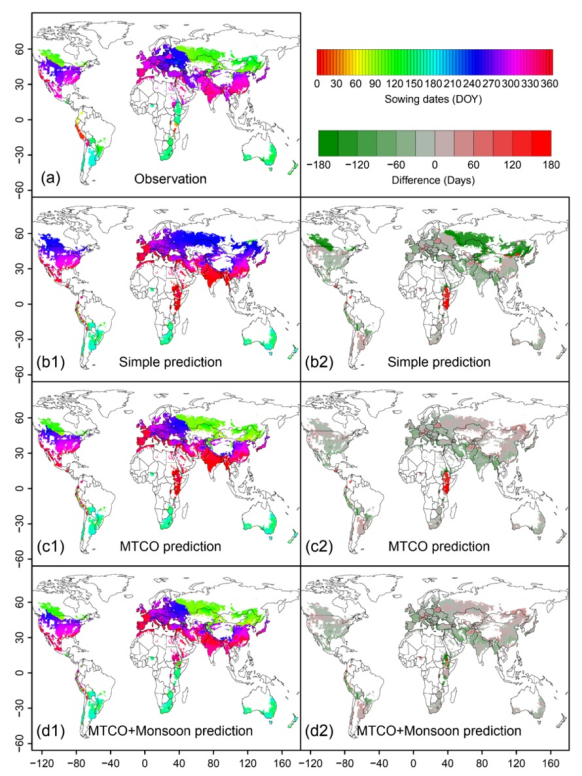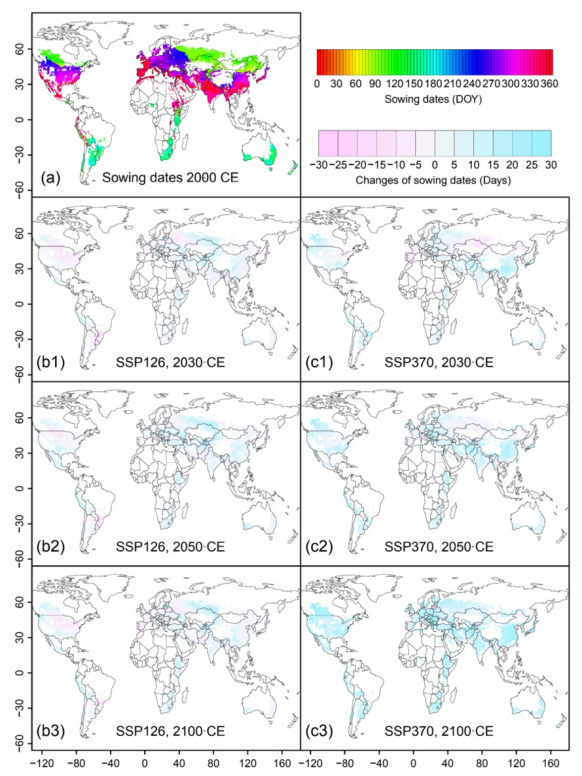Sowing time directly affects crop yield, and how does climate change affect farmers' choice of sowing time? Recently, Associate Professor Wang Han’s Research Group of the Department of Earth System Science (DESS), Tsinghua University has, in the light of global observation data and model simulation, found that the global pattern of wheat sowing dates results from optimal yields. This finding, which reveals the adaptation of farmers' sowing behavior to long-term climate state, provides support for reliably simulating crop sowing time.
Crop models, as important tools to study the response of crop growth to environmental change, are widely used in crop yield prediction and climate risk assessment. The sowing date is an essential input variable of crop model, which directly affects the accuracy of modeling results. Observational data show that due to the impact of climate change, global crop sowing dates have changed to varying degrees in the past decades, and adjusting sowing dates is also considered to be the most economical and effective measure to deal with the adverse effects of climate change. However, due to the lack of understanding of the change pattern of sowing dates, the current crop models generally presuppose a fixed sowing date, regardless of its change with time and environment. Although this treatment can reflect the spatial pattern of the current crop sowing dates, great uncertainty in forecasting future yields can be caused, which greatly restricts the ability of human beings to cope with climate change scientifically.
To solve the above problems, the Research Group takes wheat, a staple crop, as a target of research, and attempts to analyze how climate conditions affect the global pattern of wheat sowing dates from two levels, census and mechanism. Considering the impact of low temperature and heavy rainfall on wheat, the research assumes that the maximum yield corresponds to the optimal sowing date. With the help of the universal crop model PCmodel (Productivity Model for Crops) developed by the research group, the macro pattern of global wheat sowing dates is successfully simulated, providing a basis for accurate prediction of sowing dates against the backdrops of climate change and supporting effective formulation of climate change adaptation strategies for sowing dates. The research results have been published in Agricultural Systems, a flagship journal in the field of agriculture and forestry science, as an article titled "Optimization-based modeling of wheat supporting dates globally".
Firstly, the physiological constraints of low temperature on wheat and the adverse effects of heavy rainfall on wheat growth were considered, and the wheat types and sowing windows suitable for different regions of the world were determined. It was hypothesized that wheat could be sown at any time with suitable climatic conditions. The wheat yield corresponding to all possible sowing dates was simulated by using PCmodel, the optimal sowing date of each region was determined according to the maximum yield, and the simulation accuracy of this method was evaluated by comparing it with observation. Finally, the sowing dates of wheat in two climate scenarios (SSP26 and SSP370) were predicted, and the impact of future climate change on the sowing dates of wheat was explored.
The simulation results of wheat sowing dates showed (Fig. 1) that temperature was the primary factor to determine the sowing dates of wheat in non-tropical areas, and the periodicity of rainfall played a major role in determining the sowing dates of wheat in monsoon areas. Considering the two constraints of temperature and rainfall intensity, and assuming that the maximum yield corresponded to the optimal sowing date, PCmodel reproduced the macro pattern of global wheat sowing date displayed by observation data. It has been found that farmers generally choose the date that can maximize the yield of wheat, and the macro pattern of global wheat sowing date is the result of optimizing the local wheat yield, which reflects the adaptation of farmers' wheat sowing behavior to long-term climate state.

Fig. 1. Global distribution pattern of wheat sowing dates. (a) corrected census-based wheat sowing dates; (b1) prediction without any additional constraints; (c1) prediction with the constraint based on the monthly temperature of the coldest month (MTCO). (d1) prediction considering both the rainfall intensity and MTCO constraint. (b2-d2) show the differences between the observations and predictions for each model.
The evaluation results of the impact of climate change on sowing dates show that (Fig. 2), slight warming (SSP26 scenario) can advance the sowing dates of wheat in humid areas (such as central and eastern North America, western Europe, northeastern China and eastern Australia), but can delay the sowing dates of wheat in arid areas (such as central and western Asia, northern and northwestern China, western Australia, eastern Africa and some parts of Latin America); Large warming (SSP370) can delay the sowing date of wheat in most areas. The change of sowing dates is the comprehensive result of weighing the influences of many factors on wheat yield, including the impact of warming on the length of growing season, the demand for water in key growth stages and the temperature threshold of winter wheat vernalization.

Fig. 2. Predicted changes in optimal wheat sowing dates under two future scenarios. (a) wheat sowing date prediction in 2000 CE, as in Fig. 1d1; (b1-b3) predicted changes under SSP126; (c1-c3) predicted changes under SSP370. Changes are expressed as ten-year averages (2020–2029 for 2030 CE, 2040–2049 for 2050 CE and 2090–2099 for 2100 CE). Negative values indicate advanced sowing dates, positive values indicate delayed sowing dates.
Qiao Shengchao, a doctoral graduate from the DESS, Tsinghua University, is the first author of the article, Associate Professor Wang Han is the corresponding author, and Professor Sandy P. Harrison and Professor I. Colin Prentice, distinguished visiting professors in Tsinghua University, are the co-authors of the article. This research is supported by the National Natural Science Foundation, among others.
Full-text link: https://doi.org/10.1016/j.agsy.2023.103608
Written by Qiao Shengchao